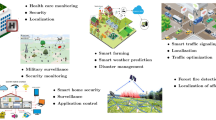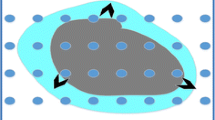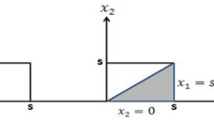Abstract
WSNs (Wireless Sensor Networks) are widely applied in environment monitoring. Especially, in large scale environment monitoring, its flexibility in deployment and self-organization are strong points. However for distribution detection of continuous objects in large scale environment monitoring, there are two primary constraints: energy consumption and the accuracy of the detection which relies on the density of the WSNs. Currently, almost all of the continuous object monitoring are based on the boundary detection, and all the energy efficiency solutions only focus on the WSNs itself. Unfortunately, with the boundary detection method, the accuracy of the continuous objects detection highly relies on the density of the sensor nodes. What is worse, it is even impossible to make sure of the density of the sensor nodes in real situation. In order to deal with these issues, we proposed the Optimal Fusion Set based Clustering algorithm based on the continuous characteristics of the targets to enhance the energy efficiency and Global Distribution Status Monitoring (GDSM) algorithm to implement the monitoring with finite sensor nodes. Firstly, a dynamic diffusion model based on the Gaussian Puff model is proposed, and then the characteristics of continuous objects are analyzed. According to the theoretic analysis and simulation results, the GDSM algorithm can achieve stable accuracy with limited sensor nodes.














Similar content being viewed by others
References
Prathap, U., Shenoy, D. P., Venugopal, K. R., et al. (2012). Wireless sensor networks applications and routing protocols: Survey and research challenges. In Cloud and services computing (ISCOS), 2012. International symposium on (pp. 49–56). IEEE.
Luan, H., Zhang, Y., Gao ,D., et al. (2011). Continuous object tracing in wireless sensor networks. In Electrical and control engineering (ICECE), 2011 international conference on (pp. 3410–3413). IEEE.
Bagci, H., & Yazici, A. (2010). An energy aware fuzzy unequal clustering algorithm for wireless sensor networks. In Fuzzy systems (FUZZ), 2010 IEEE international conference on (pp. 1–8). IEEE.
Khaleghi, B., Khamis, A., Karray, F. O., et al. (2013). Multisensor data fusion: A review of the state-of-the-art. Information Fusion, 14(1), 28–44.
Nowak, R., & Mitra, U. (2003). Boundary estimation in sensor networks: Theory and methods. In Information processing in sensor networks (pp. 80–95). Springer: Berlin Heidelberg.
Li, F., Zhang, C., Luo, J., et al. (2014). LBDP: Localized boundary detection and parametrization for 3-D sensor networks. IEEE/ACM Transactions on Networking (TON), 22(2), 567–579.
Angeles Serna, M., Bermudez, A., & Casado, R. (2013). Circle-based approximation to forest fires with distributed wireless sensor networks. In Wireless communications and networking conference (WCNC), 2013 IEEE (pp. 4329–4334). IEEE.
Nowak, R., & Mitra, U. (2014). Localized and precise boundary detection in 3-D wireless sensor networks. In Networking, IEEE/ACM transactions on (p. 99)
Hong, H., Oh, S., Lee, J., et al. (2013). A chaining selective wakeup strategy for a robust continuous object tracking in practical wireless sensor networks. In Advanced information networking and applications (AINA), 2013 IEEE 27th international conference on (pp. 333–339). IEEE.
Lee, W., Yim, Y., Park, S., et al. (2011). A cluster-based continuous object tracking scheme in wireless sensor networks. In Vehicular technology conference (VTC Fall), 2011 IEEE (pp. 1–5). IEEE.
Chauhdary, S. H., Lee, J., Shah, S. C., et al. (2012). EBCO-efficient boundary detection and tracking continuous objects in WSNs. KSII Transactions on Internet and Information Systems (TIIS), 6(11), 2901–2919.
Serpen, G., & Gao, Z. (2014). Complexity analysis of multilayer perceptron neural network embedded into a wireless sensor network. Procedia Computer Science, 36, 192–197.
Yu, Y., & Zhang, L. H. (2014). WSN location method based on BP neural network in NLOS environment. In Wireless communication and sensor network (WCSN), 2014 international conference on (pp. 321–325). IEEE.
Nam, K.D., Noh, S., Park, S., et al. (2011). Reliable continuous objects detection algorithm in wireless sensor networks. In Consumer communications and networking conference (CCNC), 2011 IEEE (pp. 740–744). IEEE.
Zhou, H., Wu, H., & Jin, M. (2012). A robust boundary detection algorithm based on connectivity only for 3D wireless sensor networks. In INFOCOM, 2012 proceedings IEEE (pp. 1602–1610). IEEE.
Cao, X., Roy, G., Hurley, W. J., et al. (2011). Dispersion coefficients for Gaussian puff models. Boundary-Layer Meteorology, 139(3), 487–500.
Mohseni, S., Hassan, R., Patel, A., et al. (2010). Comparative review study of reactive and proactive routing protocols in MANETs. In Digital ecosystems and technologies (DEST), 2010 4th IEEE international conference on (pp. 304–309). IEEE.
Hainan, C., Guangcong, L., Xiaoling, W., et al. (2014). Optimal Fusion Set based clustering in WSN for continuous objects monitoring. In 9th international conference on communications and networking in China. IEEE.
Acknowledgments
This work is supported by the 2014 Pearl River S&T Nova Program of Guangzhou (No. 2014J2200023), 2014 Foshan Science and Technology Project (No. 2014HK100103), the Open Fund of Guangdong Provincial Key Laboratory of Petrochemical Equipment Fault Diagnosis (No. GDUPTKLAB201304), the 2014 Shenzhen City “Knowledge Innovation Program” Project (No. JCYJ20140417113430604), the Open Project Foundation of Information Technology Research Base of Civil Aviation Administration of China (\(No. CAAC-ITRB-201406\)), the Science and Technology Project of Guangzhou (No. 7415538980596), the Open Project of Shanghai City Information Security Comprehensive Management Technology Research Laboratory (No. AKG2009002), the 2013 Special Fund of Guangdong Higher School Talent Recruitment, the Educational Commission of Guangdong Province (No. 2013KJCX0131), the Special Funds of Guangdong High-tech Development Project (No. 2013B010401035), and the Guangdong Province University Student Innovation and Entrepreneurship Training Project 2014.
Author information
Authors and Affiliations
Corresponding author
Rights and permissions
About this article
Cite this article
Wu, X., Chen, H., Wang, Y. et al. BP neural network based continuous objects distribution detection in WSNs. Wireless Netw 22, 1917–1929 (2016). https://doi.org/10.1007/s11276-015-1074-1
Published:
Issue Date:
DOI: https://doi.org/10.1007/s11276-015-1074-1




